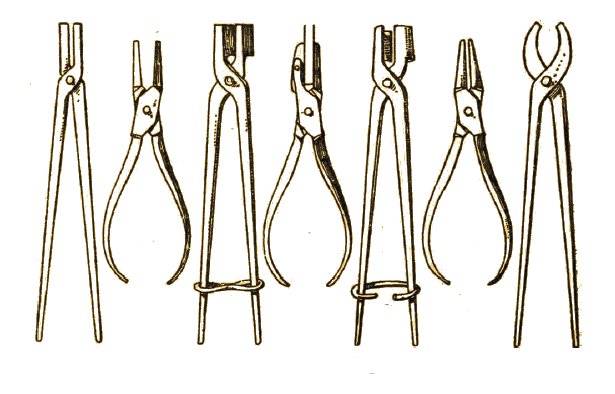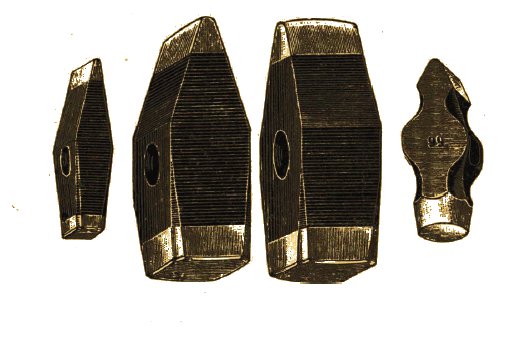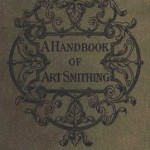Wrought Iron | Blacksmithing Tools
Wrought Iron | Blacksmithing Tools

Wrought Iron : Blacksmithing Tools
The tools necessary for carrying out the many aspects of the "Art Blacksmithing" craft, depended on the work that was to be executed. There are blacksmithing tools that were developed for measuring and preparing work, supporting and securing an object (to be able to work on it); plus tools for cutting and dividing, as well as various kinds of hammers, drills, borers, punches, and screwing-tools; that the blacksmith used in the forging, welding, and finishing of wrought iron.Here is an overview of the different types of blacksmithing tools :
Blocks, anvils and gripping tools
- The Anvil, which is made of wrought iron, serves the bearing or supporting the material to be 'wrought' (defined as: "Beaten out or shaped by hammering"). Its upper 'face' consists of a welded steel-plate which is smooth and slightly 'domed'. Sizes of the anvil vary. In the early days of blacksmithing, the anvil was fixed to a wooden-block, set in a barrel filled with pressed sand, or attached with spikes to a tree stump. Smaller ones were fastened to a bench or remain unfixed. The 'beak' (or 'horn' is a conical-shaped extension of the 'face'(or hammering surface); and comprises one end of the anvil. There are beakless, one-beaked and two-beaked anvils, which assist in forging rings, scrolls, and curves. Anvils of smaller and mostly square faces with two long beaks, were called 'Beak-Irons'. Ones shaped into a cubic form were known as 'Stakes'. Anvils often have holes, some square and others round, ground into the face for receiving tools or 'Swages' for molding iron in 'relief'(i.e. the projection of forms or figures from a flat surface).
- Swages, are used in blacksmithing when the object to be produced is too difficult or complicated for ordinary forging on the anvil, as in the fabrication o three-sided and half-round rods, rounded bodies, grooved forms, and ornaments in relief. Half-round and 3-sided rods, rods and plates ornamented on one side only, half-round bodies, only require one swage, which being made of wrought iron, is steeled on the face and set in the anvil. The iron, which has been roughly worked into an approximate form beforehand, is hammered into this swage while red-hot. Whole round forms, bosses, six-and eight-sided rods, necessitate the blacksmith to use a pair of swages or top and bottom tools, which together may form a closed box or tubular shape.
- The 'Upperswage' is generally shaped like a set-hammer. The wrought iron items being forged are either kept in one position, or turned about in the swage, pushed lengthwise forward, according to their character. The swages are made by filing and turning , or by introducing a steel core between the red-hot 'Upper and Lower Swages' which take its form under the hammer. In order that top and bottom tools may fit properly and not be displaced during the work they are either secured by grooves or held by a spring.
In order to hold the metal securely, a vice is required; which comes in various forms and sizes. It has two 'cheeks' or jaws, one fixed to the bench or to a other support; the other is connected with it and adjustable. The jaws are opened and shut by means of a horizontal screw which is set in motion by a
wrought iron pin. A spring keeps the jaws open. In the blacksmith's vice, the moveable jaw contains a curve, consequently the inner jaw-surfaces are only parallel at one particular width. This disadvantage has brought about the parallel vice, which is made according to various systems.Some types of vices used in
blacksmithing are :
- False Vice Jaws or Clamps, are made of wrought iron, lead, and wood and are sometimes held together by a spring. They fit between the jaws of the vice, their use being to protect the object held from indentations.
- A Chamfer-Clamp is a hand-vice, the jaws of which rise obliquely. Used for certain blacksmithing work, such as the removal of sharp edges, is more convenient than those with perpendicular jaws.
- The Hand-Vice , was developed for hand use in blacksmithing for small objects. It is a small unfixed vice, which is opened and closed by means of a key or flanged screw.
- The Tail-Vice is a hand-vice fitted with a handle, which latter is sometimes hollow in order to permit of manipulating long articles, wire, etc.
Blacksmith Tongs and Pliers
Next to vices, tongs are the most important group of shop tools for holding objects.
- Blacksmith Tongs are used to introduce and withdraw articles from the fire, and to hold them while being forged. They are comparatively large and have an ordinary form, or the jaws may be curved sideways. Closed or open rings, driven with the hammer on to the shanks of the tongs, lighten the task of continuous gripping.
- Smaller 'Flat-Nosed' Pliers used especially in the manipulation of cold metal, have straight roughened jaws and bent shanks.
- 'Parallel Pliers' have jaws that remain parallel to each other whether open or closed.
- 'Wire' or 'Round-Nosed' Pliers have conical jaws and are used to bend or twist wire.
 Blacksmith Hammers
Blacksmith Hammers
There are many different forms of hammers that were in use and are still being used in
blacksmithing today:Aside-from the 'Crank-Hammer', which is worked with the foot, and the 'Stamp' and 'Tilt-Hammer' which are worked by water or steam-power; there are a large variety of hand-hammers. These are made of
wrought iron and generally have two hardened steel surfaces, a hole located at the center.
Blacksmith's or hand-hammers and a handle of hard wood of a round or elliptical section. If the steel surface of the hammer is broad, either circular, or quadrate at both ends it is called a face; if it is narrow, angular, or oval, at one end; it is a " pane ". Hammers are distinguished according to sizes:
- The Sledge-Hammer, weighs from 6 to 20 lbs. , has a handle from 30 to 40 inches long; and is used or swung with both hands.
- The 'Hand-Hammer', (used most often by the blacksmith) weighs from 2 to 5 lbs. and has a handle that measures 12 to 16 inches long.
- The 'Engineer's Hammer', weighs up to 1 lb. and has a proportionate handle. The cross pane ordinary B hammers have a face and a pane at right-angles to the handle. In Straight panes the pane runs axe-ways parallel with the direction of the handle.
- The 'Block Hammer', has two slightly domed faces.
- The 'Flat Hammer', has two flat faces.
- The 'Hollowing Hammer', has two rounded convex faces.
- 'Set-hammers', are not actual hammers as they are not used for direct striking. Their forms are those of hammers, however; they are held in loose handles, and like chisels and punches, are used to cut, round off, or make holes. Set-hammers are distinguished as straight, oblique, and round; or as 'cold-chisels' with handles namely; 'handled-chisels', 'hollow-chisels', and 'chamfering-hammers'.
'Cold' or ' Cutting-Chisels'
Besides the Set-Hammers, there were other
blacksmithing tools that were used for cutting and chiseling. They are classified as:
- 'Straight' or 'Flat' chisels, which have a broad edge
- 'Cross-Cut' Chisels, with a narrow edge, half-round chisels, and gouges. Chisels are made of steel with hard tempered cutting edges, but not hardened heads, and are from 3 to 8 inches long.
- The 'Cutting-Chisel', is wedge-shaped and has a shank, which is set in the anvil under the object to be cut. The cutting can be done on both sides simultaneously. Small or thin iron, and wire; are cut with, Cutting-Plyers or 'Nippers', the blades of which are made of sharpened steel.
Shears
Shears are used in
blacksmithing to cut sheet metal, hoop, and flat iron, as well as wire. Some examples of these are:
- 'Lever Shears', in which the cutter works on a pin that is in a fixed lower jaw;
- 'Parallel Shears' that work in a parallel direction with a drawing motion; Circular cutting pliers or nippers, the. Shears and cutting-pliers or nippers, the jaws of which are round, that work on center-pivot and overlap a moderate amount.
- 'Hand-Shears'', serve to cut off small or thin pieces of metal, and are similar to ordinary scissors, only proportionately stronger in the front; the parts located at the back, are similar to those of flat-nosed pliers.
- 'Stock-Shears' are used to cut heavier metal, and have a fixed jaw, over which; a one-armed lever has a pin and works like a hinge.
This article is an edited version of the original text from "A Handbook of Art Smithing"

Click Here to Download the entire eBook version of “A Handbook of Art Smithing”
Share:

 Blacksmith Hammers
Blacksmith Hammers